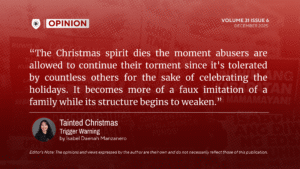By Keith Legarde | October 1, 2021
Like Trese Again
CULTURE is a big part of our everyday lifestyle, from the way we dress, the familial traditions, our beliefs, and even the origins of the things that we grew up with. Apart from the classic Original Pinoy Music (OPM) songs that we love listening to on the radio every morning, the games we used to play with our friends, or the stories our grandmothers had told us contributed to our exposure to the wonderful products of our culture, including comics, at a young age. Generations before us were big komik readers because it became a gateway to combine reality and fiction. With that, Netflix’s new series, Trese, serves as a bridge to bring our culture into different parts of the world, accompanied by thrilling storylines that will leave you wanting more.
Trese Years and Beyond
With its adaptation from a komik-based story into a Netflix show, it gives a good light on Philippine Culture and the love of Filipinos towards crime-fighting stories. Budjette Tan and Kajo Baldisimo are the makers of Trese alongside Jay Oliva who is also a part of the production of Doctor Strange and The Legend of Korra. The story was initially published in 2008 by Visual Print Enterprises under Alamat Comics. As of this date, the story has seven issues published locally. The first episode of Trese was released on Netflix in the United States on June 10 and was released globally the following day. The show is currently available for streaming with 6 episodes full of crime-fighting action that history enthusiasts and Philippine Mythology lovers will enjoy.
Past in Present Times
The main character, Alexandra Trese, a babaylan (shaman), resides in the bustling city of Manila. She is a detective among the Manila cops who solve crime cases with historical origins behind them. Trese is no ordinary detective, with her being the mediator between the underworld and humanity making sure that supernatural beings don't mess with the common folk under her watch. Working alongside her are the demigod twins, Crispin and Basilio. Crispin and Basilio were referenced from Jose Rizal’s Noli Me Tangere written during the Spanish colonial period.
Santelmo, a fire entity who aids Trese in her supernatural crime-fighting job is on speed dial through a Nokia cellphone, referencing the 70s. Santelmo’s contact number, 003231870, is a reference to the Binondo fire which happened on March 23, 1870. The incident happened on Pasaje de Norzaragay which is a famous shopping area in Manila during the 70s. Trese’s mother explained that Santelmo was involved in the 70s fire incident which makes the dialed number for Santelmo the date of the fire incident, 0-03(March)-23-1870.
Nuno, who resides in manholes is another valuable aid that helps her in her criminal cases. A nuno is part of our folklore — a race of little people that resides in mounds of soil. ‘Nuno sa Punso,’ the character's known name translates to ‘ancestor’ (nuno) and ‘anthill’ (punso). They avoid sunlight because of the belief that it will turn them into stone, making Nuno, reside only in manholes and come out during the night.
Supernatural is Super-Natural
Although the show has its own fair share of origins in historical means, the show doesn’t limit itself to merely history, but also Filipino folklore. It includes aswangs, or man-eating vampires; beasts that are half-horse in looks but gigantic in size, the tikbalang; tiyanaks or the arachnoids in the provinces; goblin-like monsters known as duwende; and even the god of war, Datu Talagbusao. Aside from the characters, known locations were referenced in the show as well, from the New Bilibid Prison, Manila Skyline, Meralco Building, and even ABS-ZNN — all familiar to the common eye.
The show further proceeds that many supernatural beings become either Trese’s ally or enemy. With many supernatural beings having their own fair share of roles in the show, it reflects well the love of Filipinos towards the folklores, cultural references, and pop-cultural references, the fascination with the crime genre. Despite the show being limited to six episodes, the unique storyline combined with modern animation and classic Manila portrayal is enough to bring the wonderful culture of the Philippines into mainstream media.
Volume 27 | Issue 1




